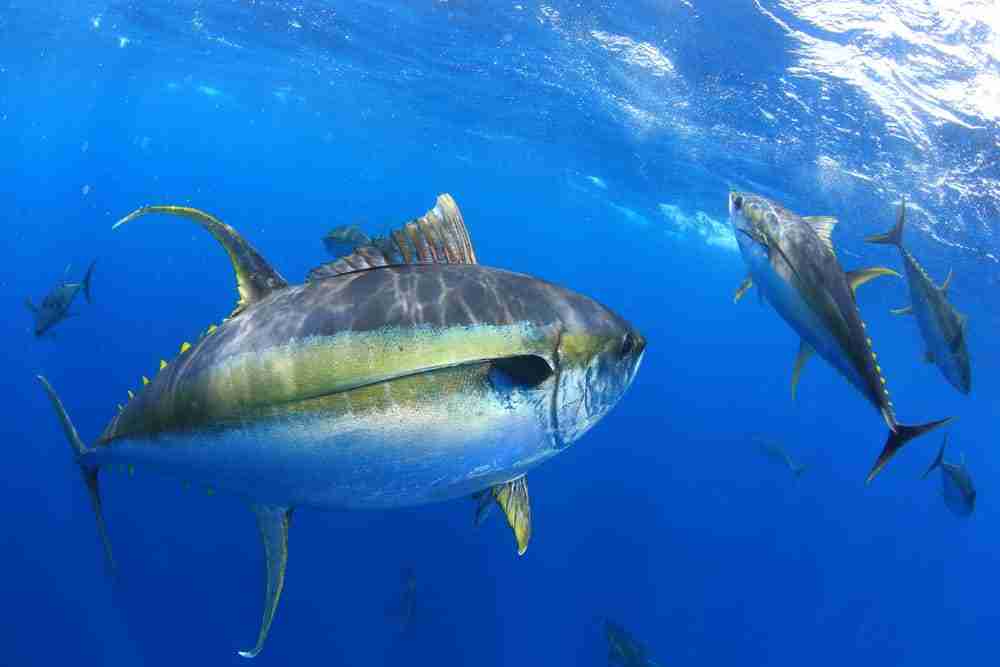Is tuna juice good for cats? As a treat, it is fine and can even help get a cat eating. But too much tuna can present its own problems. Read on to learn more…
- Is it Ok to Give Cats Tuna Juice?
- Read the Ingredients Label Before You Buy
- Is Sodium in Tuna Water a Problem for My Cat?
- Can My Cat Eat Tuna Set In Oil?
- Is Tuna Juice Good for Your Cat?
- How Much Tuna Water Can Cats Have?
- Making Tuna Juice for Your Cat
- Can I Buy Tuna Juice for My Cats?
- Wrapping Up – Use the Tuna Sparingly
Do you feel like a tuna fish sandwich for lunch? As you start opening the can of shredded albacore, your kitty wanders into the kitchen. Since the cat’s sense of smell is up to 40X better than humans, she smelled that tuna from the living room.
Now she’s paced around your feet, rubbing herself against your legs while mewing. While you’re not going to give her any of the tuna mayo you’re going to mix, you wonder if it’s okay to give your cat tuna juice, and is tuna juice good for cats?
I mean, it’s practically just fish water, right?
Is it Ok to Give Cats Tuna Juice?
For a straightforward answer, yes, it’s perfectly fine to give your cat some tuna juice from the can from time to time. However, the concerns around mercury toxicity in tuna mean that it’s not a suitable staple food for your cat’s diet.
In recent years, the danger of eating canned tuna increased after the discovery of microplastics in the tuna meat. Microplastics are the result of plastic breaking down to microscopic size in the ocean. These microplastics end up in the fish, releasing toxins into the tuna.
Canned tuna juice tastes terrific to your cat, but the brine or spring water can come with several preservatives and artificial ingredients incorporated into the water to improve the shelf life of the fish. Tuna canned in brine also includes high levels of sodium which is bad for your cat’s health.
If you’re going to feed your cat some tuna water, make sure it comes from a can of high-quality fish that has been canned in spring water. We recommend avoiding the white-labeled tuna brands and go with something like John West instead.

Read the Ingredients Label Before You Buy
Before you pick up any old can of shredded albacore off the shelf at the supermarket, take a second to read the ingredients label. You probably expect every canned tuna product to be the same, but that’s not the case.
Some manufacturers can the fish with oils to improve the consistency of the tuna and extend its shelf life. Check the label for the addition of soybean oil, olive oil, or vegetable broth mixed. You can also get tuna canned in brine or spring water. As a concerned cat owner, the best option is tuna packed in spring water.
Is Sodium in Tuna Water a Problem for My Cat?
The sodium content in tuna canned in brine is a problem for cats. As humans, we already know that high sodium levels in our diet are bad for our health. High sodium diets lead to the onset of heart disease and digestive complications.
However, cats don’t experience the same issues with sodium affecting the cardiovascular system. However, sodium may cause problems with your cat’s digestion, especially in high amounts. Avoid feeding your cat tuna juice with brine more than once a week to avoid increasing the sodium levels in their body.
Can My Cat Eat Tuna Set In Oil?
Cats evolved as “obligate carnivores.” That means that cats can only eat a diet consisting solely of meat. They also prefer lean meats, such as those they get from eating rodents and birds in the wild.
More than 95% of your cat’s daily nutritional requirements come from protein, with the remaining 5% from fat. Oils used in the setting of canned tuna products present a large quantity of fat in a single serving. Your cat might eat the oil, but they’ll have severe digestive problems a few hours later.
Is Tuna Juice Good for Your Cat?
From the second you get the can of tuna off the shelf in the pantry, your cat starts going wild. Cats love tuna juice, and they love it almost as much as they love feasting on tuna itself. As long as you give your cat the tuna juice in moderation, you’re not going to have any health problems with your kitty.
Tuna juice has some benefits for your cat and some drawbacks. Let’s unpack the pros and cons of feeding your cat tuna juice.

Tuna Water Increases Hydration in Your Cat
Feeding your cat tuna juice increases their hydration levels. Cats are notorious for skipping out on drinking water. If your cat gets dehydrated, it could end up experiencing a medical emergency. It’s for this reason that chronic kidney disease is a problem in many cats.
Cats don’t feel the need to drink water often, and they’ll often pass on it for hours before they realize they’re thirsty. Giving them tuna juice to drink is a great way to provide them with some water and some nutrients.
It’s not something you’d want to do every day, but it can be a great occasional treat to increase hydration.
Might Get Your Cat Eating Again
If your cat is a picky eater or a fussy eater you might find that they go off their food regularly or need flavors changed up to maintain their interest. If your cat licks food but doesn’t eat it might be getting bored.
Adding tuna juice to a meal can boost their interest in the food and keep them eating. You might only need a few drops on the food to get them eating food they might have gotten bored with!
Too Much Tuna Can Change Your Cats Eating Habits
If you decide that your cat likes drinking tuna juice, you might decide to start feeding them some tuna. It’s important for cat owners to note that cats can become tuna junkies. If you feed it to them too often, they’ll start developing food aversions to their kibble.
Your cat may refuse to eat anything else but tuna, and that can be a problem. First, it’s expensive, and second, if your cat stops eating, it can develop liver disease almost overnight. If your cat doesn’t eat for 24-hours, it’s probably going to result in a trip to the emergency room.
Feeding your cat tuna once a week or so is okay, but don’t make it a part of their staple menu. We recommend two to three feedings of tuna juice a week at the maximum. If you do end up feeding your cat tuna, you may also notice changes in their personality.
It’s also important for cat owners to understand that feeding their cat an all-tuna diet is a bad idea. Tuna doesn’t have all the nutrients your cat needs to survive. That’s why it’s a better idea to feed them kibble and use the tuna juice to enhance the meal’s flavor for your cat.
Some cat owners that feed their kitty an all-tuna diet notice that the cat gets more aggressive, and they might start biting or scratching you if you don’t give them the tuna they want for dinner.

How Much Tuna Water Can Cats Have?
When feeding your cat tuna juice, the biggest concerns you have are mercury toxicity and microplastic poisoning. With mercury toxicity, the larger fish in the ocean, such as tuna, accumulate the most mercury in their flesh. Choosing a species like light-chunk rather than albacore ensures you get the lowest levels of mercury possible.
However, it’s important for cat owners to note that you would have to eat a can of tuna three times a week for months on end to see the results of mercury toxicity begin to show up in your life. Therefore, feeding your cat some tuna juice from time to time isn’t going to give them mercury poisoning.
Microplastics are becoming increasingly problematic in the oceans. These almost invisible plastics are so small that you won’t see them in the canned tuna. Consuming these microplastics is bad for your health since they release phytoestrogens into the body.
However, both issues are relatively minor in cats as long as you keep the tuna meals and juice treats to a minimum. You can limit your tuna juice feedings to two to three times a week for the best results. Any more than this, and your cat may start refusing their dry kibble.
Making Tuna Juice for Your Cat
You always have the option of making fresh tuna juice for your cat. To make tuna juice yourself, visit the supermarket and purchase a can of high-quality shredded albacore tuna.
Take it home and open the can, and add the tuna to a bowl, along with the juice.
Add another half a cup of water to the bowl and muddle the tuna with the water.
Leave the tuna juice to ferment in the fridge overnight, and then strain the tuna meat through a colander or kitchen sieve. You should get a cloudy, light-yellow liquid after squeezing. Drain the liquid into a Tupperware and store it in the fridge for up to five days. Use the tuna juice as a topper for your cat’s kibble meals, or give it to them as a treat.
Can I Buy Tuna Juice for My Cats?
Yes, there are pet-friendly tuna juice products available from your favorite pet store. Several cat food brands make toppers for kibble-based foods to improve the taste and consistency, making the kibble more appealing to your kitty.
However, purchasing this store-bought topper is expensive. You’re better off going with our idea for homemade tuna juice for your cat. Not only will it save you a bundle, but you can use the leftover tuna after straining for a meal for your kitty.
Wrapping Up – Use the Tuna Sparingly
As mentioned, there are plenty of advantages to giving your cat the occasional treat of tuna juice. It improves their health while breaking up the monotony of their diet.
However, keep in moderation; the last thing you need is a tuna junkie roaming the house.
